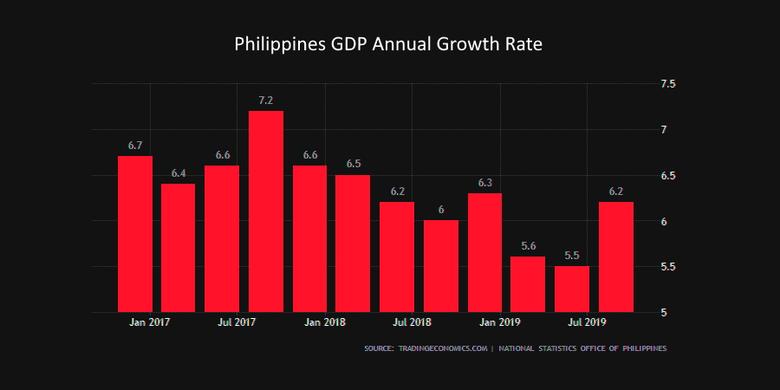
PHILIPPINES GROWTH 5.7-6.3%

IMF - November 18, 2019 - IMF Staff Completes 2019 Article IV Visit to Philippines
- After a soft patch in the first half of this year, the Philippines’ GDP growth is expected to strengthen in the remainder of 2019 and in 2020, underpinned by government spending catching up with targets, and the recent monetary policy easing.
- Near-term downside risks to the outlook have increased, reflecting increased risks from global trade tensions, shifts in global financial conditions, and natural disasters.
- Macroeconomic policies have reacted appropriately to the slowing growth and decreasing inflationary pressures. The planned increase in government spending for 2020 and the recent monetary policy easing will help the economy move back to its growth potential and achieve the inflation target.
- Bold implementation efforts are needed for the strong structural reform momentum to lift medium-term growth and reduce poverty.
An International Monetary Fund (IMF) staff team led by Thomas Helbling visited Manila, Clark City, and New Clark City from November 5−18, 2019 for the 2019 Article IV consultation. At the conclusion of the visit, Mr. Helbling issued the following statement:
“The Philippines remains one of the best-performing economies in the region. After a soft patch in the first half of the year, economic growth is now recovering. Inflation has declined, reflecting lower oil prices, rice tariffication, and a decisive monetary policy response to the inflation spike in 2018.”
“Growth is projected at 5.7 percent in 2019, unchanged from the October 2019 World Economic Outlook, and to strengthen to 6.3 percent in 2020, underpinned by an increase in government spending and the recent monetary policy easing. The medium-term economic outlook remains favorable, especially if the strong structural reform momentum continues.”
“The inflationary pressures of 2018 have dissipated this year. With the current projections of global commodity prices and domestic policy trajectories, inflation is projected at 1.6 percent by end-2019 and at 3 percent by the end of 2020, within the 2-4 percent target range.”
“Risks to the outlook are tilted to the downside. The near-term rebound in GDP growth could be weaker than expected because of global trade tensions and related policy uncertainty, a change in global financial conditions, and natural disasters. On the upside, structural reform progress and infrastructure improvements could boost confidence and growth.”
“Against this backdrop, this year’s Article IV consultation discussions with the authorities focused on policies to keep economic growth in line with its potential, achieve the inflation target, and address financial stability risks, and on structural reforms to lift the economy’s growth potential and further reduce poverty. The IMF staff team highlighted the following:
-
The small fiscal stimulus planned for 2020 is timely and appropriate in magnitude. Within the budgeted fiscal envelope, however, there is scope to expand and better target social spending and infrastructure.
-
The recent cuts in the BSP’s policy rate are appropriate for achieving the inflation target in the next one to two years, barring any unforeseen events.
-
The Philippines has space for an expansionary macroeconomic policy response should downside risks materialize.
-
With economic growth expected to pick up again, rapid credit growth may reemerge. The BSP should be prepared for macroprudential policy responses if renewed high credit growth poses risks to systemic financial stability.
-
Structural reform progress has been strong and important bills have been passed, including rice tariffication, tax reform, a national digital ID, the ease of doing business, and BSP charter amendments. It will be critical to speed up the implementation of reforms. Further steps could be taken to promote inclusive growth, including continued tax reform, relaxing restrictions on foreign investment, broadening poverty reduction efforts, easing the stringent banking secrecy law, and upgrading the capacity of public administration.”
“Prudent macroeconomic management and a strong structural reform momentum have made the Philippine economy more resilient, reinforced growth, and helped to reduce poverty. The IMF will continue to cooperate with the authorities in their efforts to achieve their development goals— through policy dialogue and support for the development of economic analysis and policy capacity.”
The IMF team would like to thank the authorities in Manila, Clark City, and New Clark City, as well as other counterparts for the candid and fruitful discussions and gracious hospitality.
-----
Earlier:

2019, October, 7, 13:00:00
RUSSIA'S NUCLEAR FOR PHILIPPINES
Rusatom Overseas JSC and The Department of Energy of the Republic of Philippines and signed Memorandum of Intent on cooperation in the sphere of small modular reactors.
|

2019, May, 29, 10:30:00
PHILIPPINES RENEWABLE UP
In a market outlook report focused on the Philippines, analytics firm GlobalData said installed capacity was cued for an 11.2-percent compound annual growth rate (CAGR) from 2019 to 2030.
|

2018, November, 28, 12:35:00
CHINA, PHILIPPINES AGREEMENT
OGJ - The governments of China and the Philippines have signed a memorandum of understanding for cooperation in oil and gas exploration and development, easing a territorial dispute in the South China Sea.
|










